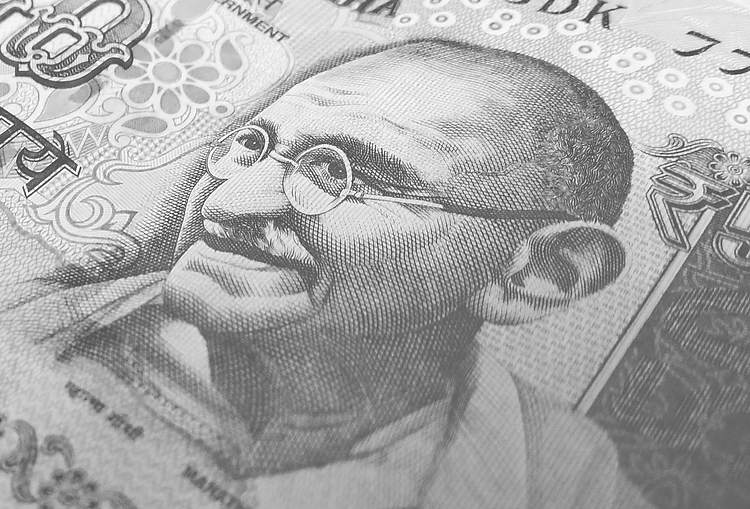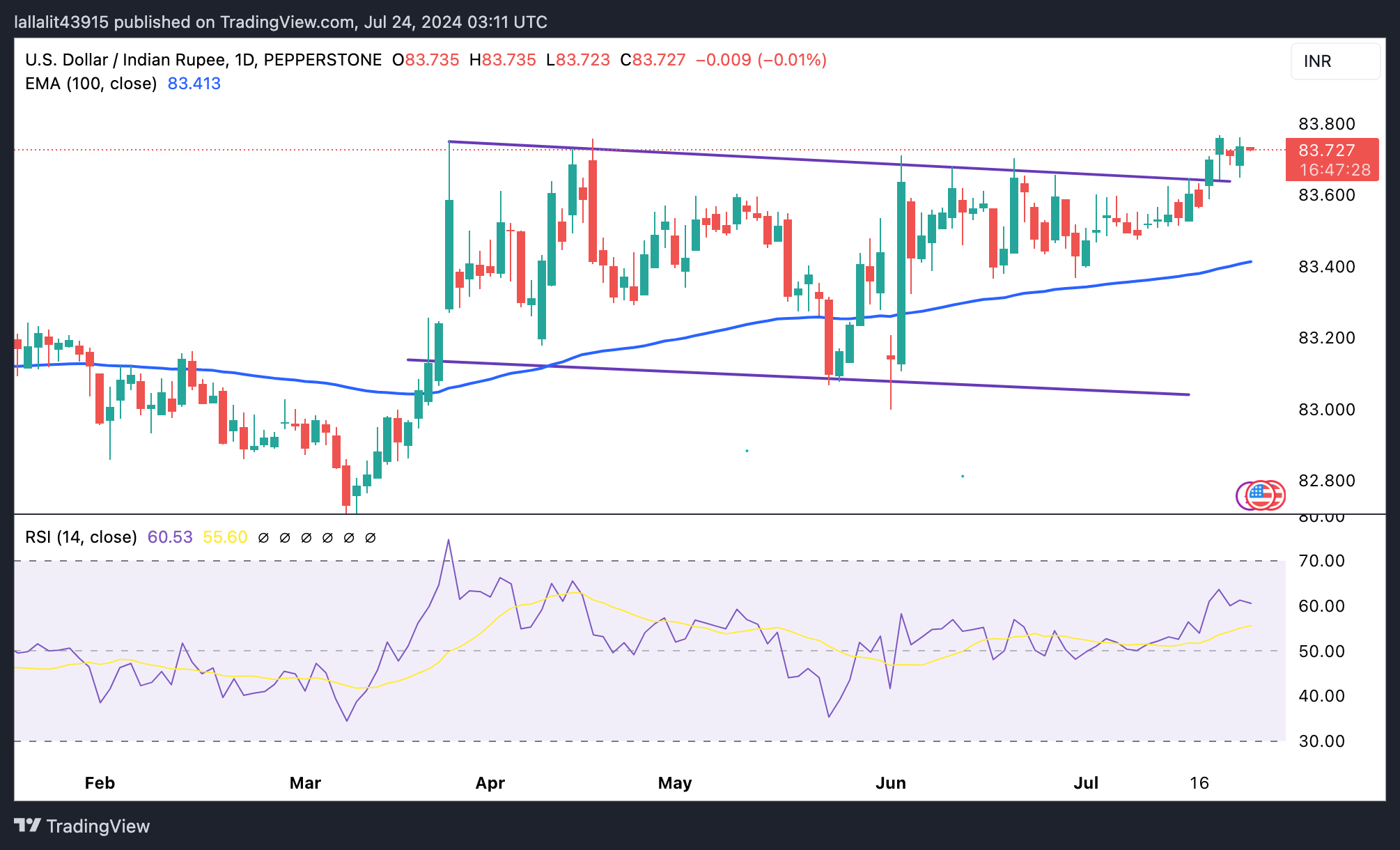Products You May Like
- The Indian Rupee loses momentum in Thursday’s Asian session.
- The Indian government’s decision to raise the tax rate on capital gains dampened market sentiment, weighing on the INR.
- The first reading of the US second-quarter GDP growth number will be the highlight for Thursday.
The Indian Rupee (INR) extends its decline on Thursday despite the softer US Dollar (USD). The INR fell to an all-time closing low on Wednesday, pressured by the decline in Indian equities after the government’s decision to raise capital gains tax from equity investments and equity derivative trades. Investors’ weak appetite for riskier assets and the renewed Greenback demand might cap the upside for local currency in the near term. Nonetheless, the decline in crude oil prices and the potential intervention from the Reserve Bank of India (RBI) could help the INR’s losses.
Looking ahead, the first reading of the US Gross Domestic Product (GDP) for the second quarter is due on Thursday. The attention will shift to the Personal Consumption Expenditures (PCE) Price Index data for June on Friday. Any further signs of cooler inflation might spur the rate cut expectation by the US Federal Reserve (Fed) and could exert some selling pressure on the USD.
Daily Digest Market Movers: Indian Rupee weakens despite the stronger PMI readings
- Benchmark Indian equity indices extended losses to a fourth straight session. The BSE Sensex fell 280 points, or 0.35%, to 80,149. The Nifty 50 dropped 65 points, or 0.27%, to 24,413 on Wednesday.
- The advanced reading of India’s HSBC Manufacturing PMI data climbed to 58.5 in July from 58.3 in June. Meanwhile, the Services PMI improved to 61.1 in the same reported period from 60.5 in June.
- The US S&P Global Composite PMI improved to 55.0 in July from 54.8 in June. Additionally, the S&P Global Manufacturing PMI dropped to 49.5 from 51.6 in the same period, weaker than the 51.7 expected. Finally, the Services PMI rose to 56.0 from 55.3.
- The advanced US Goods Trade Balance came in at $-96.0 billion in June, compared to $-99.4 billion in May, below the estimate.
- The preliminary US Gross Domestic Product (GDP) is estimated to grow at an annualized rate of 2.0% in the second quarter, which is higher than the previous quarter of 1.4%.
Technical analysis: Indian Rupee remains vulnerable in the longer term
The Indian Rupee edges lower on the day. The USD/INR pair has been making higher highs and higher lows, while holding above the key 100-day Exponential Moving Average (EMA) on the daily chart, confirming a bullish structure. Additionally, the 14-day Relative Strength Index (RSI) stands in a bullish zone around 63.00, suggesting that there is room for further upside.
The first upside target to watch is the all-time high of 83.79. Bullish candlesticks and consistent trading above this level could push the pair to the 84.00 psychological level.
If USD/INR trades consistently below 83.65 (low of July 23), the pair could drop back down to 83.51 (low of July 12). Further south, the next contention level is seen at 83.42, the 100-day EMA.
US Dollar price today
The table below shows the percentage change of US Dollar (USD) against listed major currencies today. US Dollar was the strongest against the Australian Dollar.
| USD | EUR | GBP | CAD | AUD | JPY | NZD | CHF | |
| USD | -0.02% | 0.05% | 0.05% | 0.34% | -0.96% | 0.08% | -0.17% | |
| EUR | 0.02% | 0.08% | 0.08% | 0.37% | -0.87% | 0.12% | -0.14% | |
| GBP | -0.06% | -0.07% | 0.00% | 0.28% | -0.99% | 0.01% | -0.22% | |
| CAD | -0.05% | -0.07% | 0.01% | 0.29% | -0.95% | 0.04% | -0.22% | |
| AUD | -0.34% | -0.36% | -0.27% | -0.29% | -1.25% | -0.26% | -0.50% | |
| JPY | 0.92% | 0.88% | 0.96% | 0.94% | 1.24% | 0.98% | 0.72% | |
| NZD | -0.08% | -0.10% | -0.02% | -0.03% | 0.27% | -1.04% | -0.25% | |
| CHF | 0.17% | 0.14% | 0.22% | 0.21% | 0.50% | -0.73% | 0.23% |
The heat map shows percentage changes of major currencies against each other. The base currency is picked from the left column, while the quote currency is picked from the top row. For example, if you pick the Euro from the left column and move along the horizontal line to the Japanese Yen, the percentage change displayed in the box will represent EUR (base)/JPY (quote).
Indian Rupee FAQs
The Indian Rupee (INR) is one of the most sensitive currencies to external factors. The price of Crude Oil (the country is highly dependent on imported Oil), the value of the US Dollar – most trade is conducted in USD – and the level of foreign investment, are all influential. Direct intervention by the Reserve Bank of India (RBI) in FX markets to keep the exchange rate stable, as well as the level of interest rates set by the RBI, are further major influencing factors on the Rupee.
The Reserve Bank of India (RBI) actively intervenes in forex markets to maintain a stable exchange rate, to help facilitate trade. In addition, the RBI tries to maintain the inflation rate at its 4% target by adjusting interest rates. Higher interest rates usually strengthen the Rupee. This is due to the role of the ‘carry trade’ in which investors borrow in countries with lower interest rates so as to place their money in countries’ offering relatively higher interest rates and profit from the difference.
Macroeconomic factors that influence the value of the Rupee include inflation, interest rates, the economic growth rate (GDP), the balance of trade, and inflows from foreign investment. A higher growth rate can lead to more overseas investment, pushing up demand for the Rupee. A less negative balance of trade will eventually lead to a stronger Rupee. Higher interest rates, especially real rates (interest rates less inflation) are also positive for the Rupee. A risk-on environment can lead to greater inflows of Foreign Direct and Indirect Investment (FDI and FII), which also benefit the Rupee.
Higher inflation, particularly, if it is comparatively higher than India’s peers, is generally negative for the currency as it reflects devaluation through oversupply. Inflation also increases the cost of exports, leading to more Rupees being sold to purchase foreign imports, which is Rupee-negative. At the same time, higher inflation usually leads to the Reserve Bank of India (RBI) raising interest rates and this can be positive for the Rupee, due to increased demand from international investors. The opposite effect is true of lower inflation.

